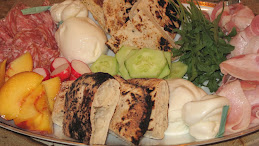
Many serious and terrible things have been done in chicken production over the last few years, supposedly in the cause of producing cheap white protein for supermarkets to sell at a profit. It is now possible to buy a whole chicken for a couple of pounds all year round. But what you get is inedible - flaccid flesh pumped full of water, fed on antibiotics and fishmeal - eating one of these birds is like trying to suck on the inside of a blister. The eggs produced by battery farming are no better. So it is not cheap to buy because it's too horrible to eat when cooked - and is certainly not edible the next day.
It is not cheap, on the other hand, to buy a free range bird from Wyndham Farm's shop at Borough - it will set you back about £10 for a medium sized bird - but it is good value. Firstly, and most importantly, it is edible. The flesh is firm textured and juicy, not watery. It has the flavour of chicken which should not be a surprise but it is not something that battery chickens have. Uncooked, the flesh is a creamy pale pink not a strange wet purple. It roasts to a deep golden brown and is wonderful to eat hot from the oven, and again cold the next day with salad for supper. Afterwards the bones, because they are strong and healthy, can be used with the giblets to make stock for soup or risotto. So there are three or four meals to be had for a tenner from this single bird. Money well spent, no?
My friend Vicki now lives in Singapore but once upon a time we shared a flat in London where we had many adventures and cooked up lots of lovely treats. One of her favourite things is roast chicken, so when she came to visit this week I decided it was definitley on the menu. And it was lovely - crispy skinned and juicy with a herbed barley stuffing and, because we've finally got summer, I served it with jersey royal potato salad and roasted red onion and green bean salad. Vicki approved.
Roast Chicken & Barley Stuffing
1 chicken, the best you can find
A couple of rashers of unsmoked bacon
Olive oil
For the stuffing
100g barley
Handful of fresh herbs, finely chopped
50g unsmoked bacon, finely chopped
1 tbspn lemon juice
1 small onion, finely chopped
1 stalk celery, finely sliced
1 egg
Salt and pepper
Soak the barley for an hour in cold water, then cook in boiling salted water for 20 minutes. Drain and refresh. Put into a bowl when it has cooled with all the other stuffing ingredients and mix thoroughly.
Rinse the chicken inside and out and pat dry with kitchen paper. Fill the cavity with stuffing and close with a toothpick. Pour a little olive oil into the base of a roasting pan and put the chicken into the pan. Season with salt and pepper and lay one or two bacon rashers over the breasts. Cook in a medium oven, gas 4/350F/175C, basting occasionally. After about 90 minutes remove the bacon, baste the bird well and roast for another 20 minutes till golden. Remove from the oven, cover with foil and allow to rest for 15 minutes before carving.
I ended up with more stuffing than would fit into the chicken so I oiled a couple of ramekins, filled them with the remainder and cooked them in a bain-marie for 30 minutes. Tomorrow's lunch was sorted.










